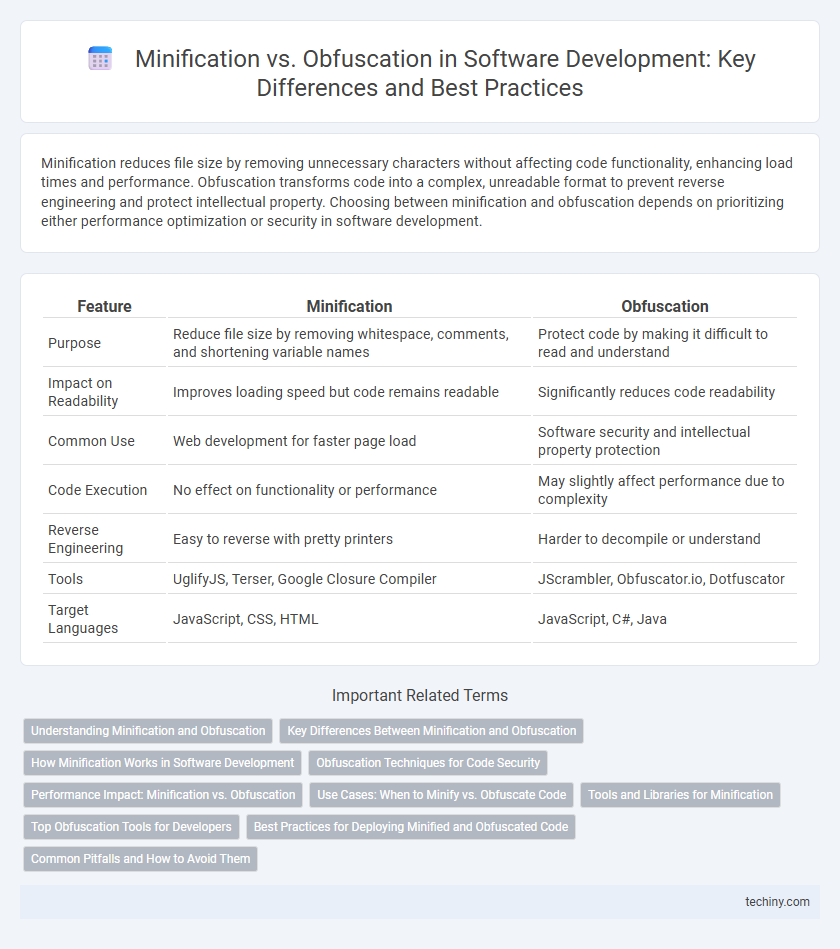Minification reduces file size by removing unnecessary characters without affecting code functionality, enhancing load times and performance. Obfuscation transforms code into a complex, unreadable format to prevent reverse engineering and protect intellectual property. Choosing between minification and obfuscation depends on prioritizing either performance optimization or security in software development.
Table of Comparison
| Feature | Minification | Obfuscation |
|---|---|---|
| Purpose | Reduce file size by removing whitespace, comments, and shortening variable names | Protect code by making it difficult to read and understand |
| Impact on Readability | Improves loading speed but code remains readable | Significantly reduces code readability |
| Common Use | Web development for faster page load | Software security and intellectual property protection |
| Code Execution | No effect on functionality or performance | May slightly affect performance due to complexity |
| Reverse Engineering | Easy to reverse with pretty printers | Harder to decompile or understand |
| Tools | UglifyJS, Terser, Google Closure Compiler | JScrambler, Obfuscator.io, Dotfuscator |
| Target Languages | JavaScript, CSS, HTML | JavaScript, C#, Java |
Understanding Minification and Obfuscation
Minification reduces file size by removing unnecessary characters like whitespace and comments from source code, improving load times and performance without altering functionality. Obfuscation transforms code into a complex and less readable form to protect intellectual property and prevent reverse engineering while maintaining its original operation. Understanding these techniques helps developers optimize delivery and enhance security in software development.
Key Differences Between Minification and Obfuscation
Minification reduces file size by removing whitespace, comments, and shortening variable names to improve load times and performance in software development. Obfuscation transforms code to make it difficult to understand or reverse-engineer while preserving functionality, enhancing security and intellectual property protection. Minification targets optimization, whereas obfuscation focuses on code protection and anti-tampering measures.
How Minification Works in Software Development
Minification in software development works by removing all unnecessary characters from source code, such as whitespace, comments, and line breaks, without altering its functionality, resulting in reduced file size and faster load times. This process typically involves shortening variable names and eliminating redundant code, which helps optimize performance, particularly in web applications. Minification is crucial for improving bandwidth efficiency and enhancing user experience by decreasing the time required to download and parse scripts.
Obfuscation Techniques for Code Security
Obfuscation techniques in software development enhance code security by transforming source code into a version that is difficult to understand while maintaining its original functionality. Common methods include variable renaming, control flow flattening, string encryption, and dead code insertion, which collectively hinder reverse engineering and unauthorized tampering. Effective obfuscation protects intellectual property and sensitive algorithms in compiled binaries and script files, making it a crucial practice for securing proprietary software.
Performance Impact: Minification vs. Obfuscation
Minification improves web application performance by reducing file size, enabling faster load times and decreased bandwidth consumption through the elimination of whitespace, comments, and unnecessary characters in code. Obfuscation, while primarily aimed at protecting source code from reverse engineering, can introduce slight performance overhead due to added complexity in variable renaming and control flow alterations. Developers prioritize minification for optimizing runtime efficiency and use obfuscation alongside it to enhance code security without significantly compromising performance.
Use Cases: When to Minify vs. Obfuscate Code
Minification is ideal for improving website performance by reducing file sizes, thus speeding up load times in production environments where code readability is not a concern. Obfuscation is suited for protecting intellectual property and deterring reverse engineering by making code difficult to understand, which is critical in proprietary or sensitive applications. Developers often use minification for front-end optimization and obfuscation for back-end or API code security.
Tools and Libraries for Minification
Popular tools for minification in software development include UglifyJS, Terser, and Google Closure Compiler, which efficiently reduce JavaScript file sizes by removing whitespace, comments, and shortening variable names. CSS minification is commonly handled by libraries like cssnano and CleanCSS, optimizing stylesheet delivery for faster load times. These minification tools integrate with build systems such as Webpack and Gulp to automate optimization during the development workflow.
Top Obfuscation Tools for Developers
Top obfuscation tools for developers include ProGuard, which effectively shrinks and obfuscates Java bytecode, and JavaScript Obfuscator, known for transforming readable scripts into complex, hard-to-understand code. Other prominent tools are Dotfuscator for .NET applications, providing robust renaming and control flow obfuscation, and ConfuserEx, an open-source protector with advanced anti-tampering features. Choosing the right obfuscation tool enhances code security by making reverse engineering significantly more difficult without compromising performance.
Best Practices for Deploying Minified and Obfuscated Code
Deploying minified and obfuscated code requires maintaining a balance between performance optimization and code security, ensuring faster load times while protecting intellectual property. Best practices include automated build pipelines integrating reliable minification tools like UglifyJS or Terser and obfuscation frameworks such as JavaScript Obfuscator, combined with thorough testing to avoid runtime errors. Source maps should be securely managed to facilitate debugging without exposing the original code structure in production environments.
Common Pitfalls and How to Avoid Them
Minification reduces file size by removing whitespace and comments but can lead to broken code if not carefully tested, especially with complex JavaScript frameworks. Obfuscation transforms code to make it harder to read and reverse-engineer but may introduce performance overhead and debugging difficulties. Avoid common pitfalls by using automated build tools with integrated testing and maintaining source maps for easier debugging and error tracking.
Minification vs Obfuscation Infographic

 techiny.com
techiny.com